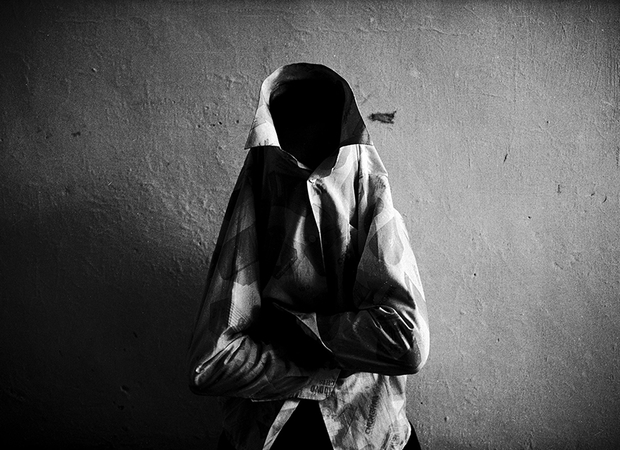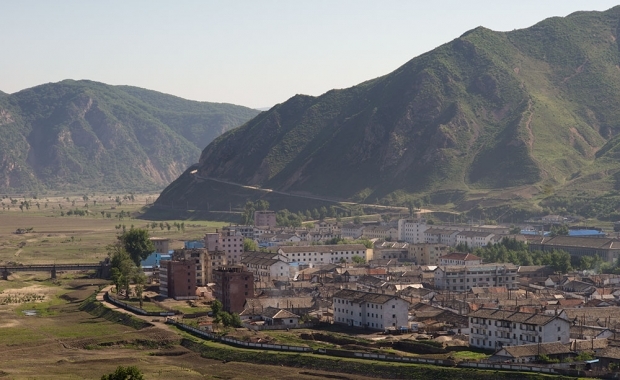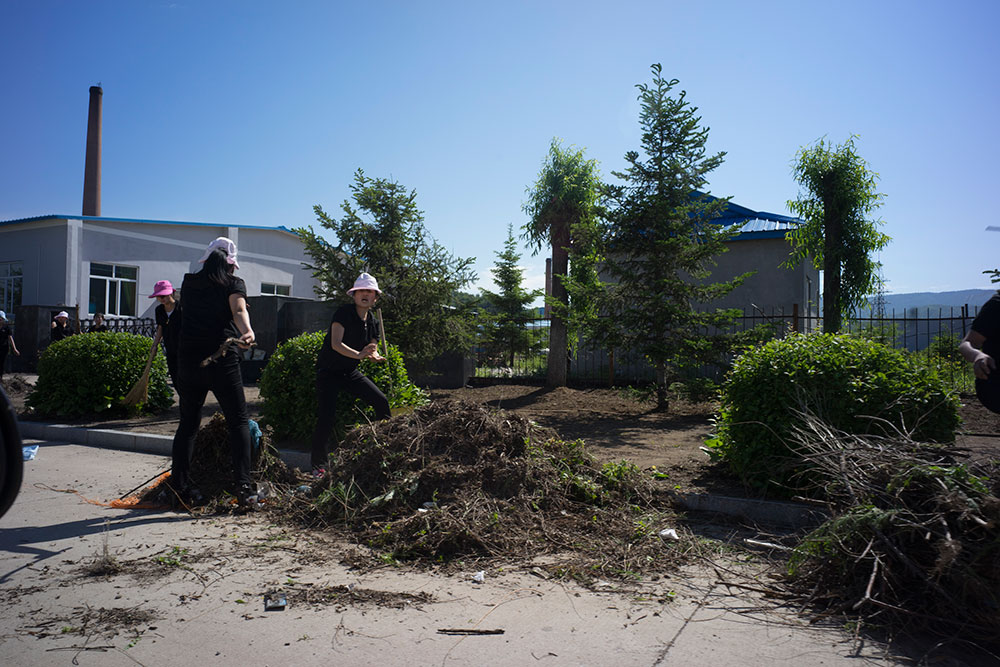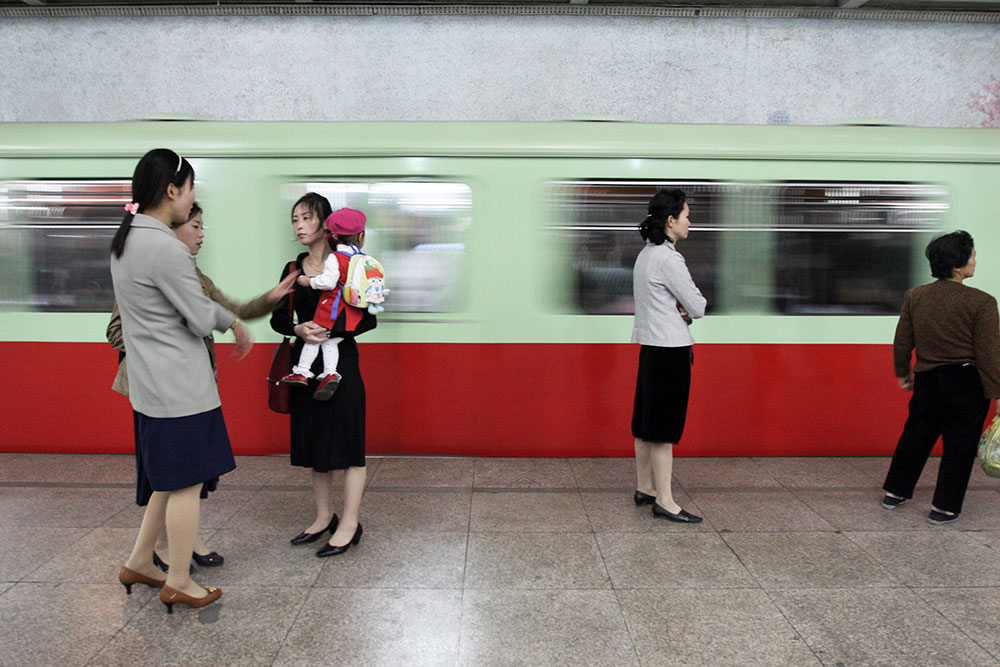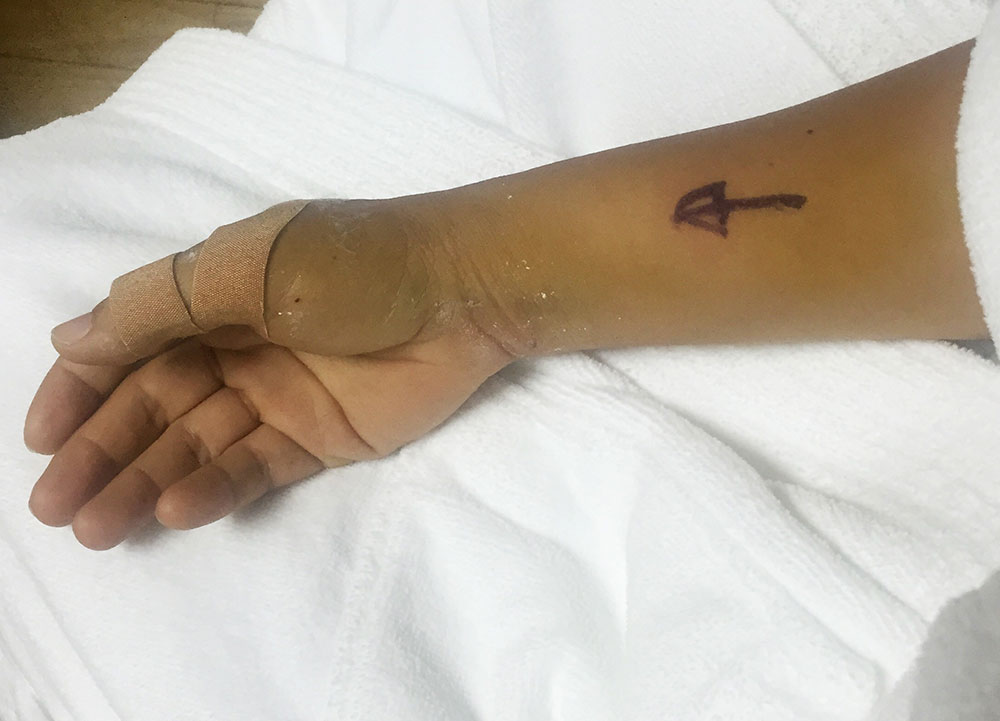Minutes after we turned off the main road and into the Tumen Economic Development Zone, we spotted a group of workers weeding along an access road.
From afar, all we could make out in the gentle early morning light was that they were women in uniforms, working amid the rows of non-descript low-rise factories like in any other China industrial area. I shot an image of the general scene through the windshield of our taxi. I thought they might be North Koreans.
I was on assignment for Le Monde working on an article about China’s economic interaction with its neighbor. Perhaps this was a way to illustrate our story.
Without hesitating, our driver, a local who had been to this industrial estate many times, took a right turn, muttering “let’s have a closer look.” Sitting in the front seat, I instinctively raised my manual-focus camera with both hands and shot two frames through my wound-down window.
Almost immediately, the women turned around, ran towards the cab, and reached into the car. I felt a pair of hands trying to rip the camera out of my grip. My hand, with fingers on the camera grip and shutter button in shooting mode, was stretched outside the car window. We were now surrounded by the women workers. Six or seven of them were pulling on my camera—the body, lens, and different parts of the strap. The strap wound around my thumb, making it impossible for me to release the camera without sacrificing my thumb.
I could see now they were a frantic mob of young Korean women, all wearing black tracksuits and blue or pink hats. They did not seem like the ethnic Korean Chinese women common in this part of northeast China. As I heard light martial music playing in the background, I realized they were indeed North Koreans.
I motioned “stop” with my left hand and said clearly and slowly in Mandarin: “Stop pulling. If you don’t want your picture taken I can delete them and show you.” They kept pulling, with all their collective strength, their eyes fired up with a ferocity I have rarely seen at such close range. Pain shot through my right hand, still gripping my camera.
I repeated myself: “. . . I can delete. . .” They kept pulling.
The camera strap see-sawed over my right thumb. I tried to grasp it with my left hand to reel back some of the strap and release the pressure, but the women were stronger. Blood oozed out of my thumb as the flesh split open in two places. “Brice, Brice…” I called out to Brice Pedroletti, Le Monde’s Beijing correspondent, who was seated behind me. Another North Korean woman was trying to open the back car door on the other side, apparently looking for a camera held by Brice’s assistant.
For a second, I locked eyes on one of the women pulling my camera. She was angry and not listening to my pleas. She was consumed by a fury that I had never encountered before, a blind hatred, an uncompromising determination. I wondered, what drove these women? What were they thinking?
* * *
China and North Korea have one of the most unusual relationships in the world. During the Cold War, Beijing acted as Pyongyang’s socialist big brother and sent troops to fight in the Korean War. In more recent times, it has been North Korea’s most important ally, biggest trading partner, and main source of food, energy, and arms. Beijing, host of the on-again, off-again Six Party Talks aimed at denuclearizing North Korea, is also Pyongyang’s diplomatic buffer—consistently opposing harsh international sanctions on its prickly neighbor.
But Pyongyang’s erratic international behavior has often left Beijing in an embarrassed bind. North Korea’s third nuclear test in February 2013, followed by the December 2013 execution of Jang Song-taek, Kim Jong-un's uncle and adviser who had close ties to Beijing, made China worry about the stability and direction of the leadership.
China’s efforts to stabilize secretive North Korea are aimed at preventing regime collapse and a refugee influx across their long and porous border. Defections and border crime involving impoverished North Koreans coming over the Tumen River have been a persistent irritant in the bilateral relationship. In the last six months, there have been a series of violent incidents on that border, leading to increasing patrols by Chinese border guards.
Two weeks ago, on June 11, Chinese border guards shot and killed a suspected North Korean defector. In April, North Korean soldiers reportedly looking for food and money killed three Chinese villagers. Last December, a North Korean murdered two older Chinese couples, prompting Beijing to file a formal complaint to Pyongyang.
All these incidents happened in the area of Helong, just over 100km southwest of where we were confrontated by the women workers. Yet, they were the opposite of the defectors and desperate North Korean soldiers who had come over the border. The women were legal migrants sent by Pyongyang to work in the Tumen North Korean Industrial Park at the invitation of the Chinese government beginning in 2012. As many as 120,000 North Korean migrants work in a few Chinese economic zones near the border, with the workers sending the government in Pyongyang cash remittances of about $2,000 each per year, contributing most of their $200 to $300 monthly wage.
Other journalists—Chinese and foreign—had previously written about and photographed North Korean women workers in Tumen—inside their factories.
I knew from my previous visits to North Korea as a reporter that people there could be paranoid. When I visited in 2008, our minder gave the six journalists in our group blue armbands with the words “ki ja” (“journalist” in transliterated Korean) embroidered in loud white letters. He warned us: “Don’t forget to wear it. Otherwise people will think you’re a spy when you photograph them.”
Perhaps I did not expect to have more trouble photographing North Koreans in China than in their own country. In my 15 years as a journalist I have been tailed, yelled at, threatened, detained, and roughed up by thugs. But this was the first time I’d been set upon with such ferocity, and sustained a lasting injury. How all this played out, though, was what really surprised me.
* * *
The pain was unbearable. I must have let go, and the strap unwound. The camera flew out of my hands.
The mob, camera in hand, backed away slightly.
I sat in the car, shaken. “Brice, my camera.” Brice opened his car door and stepped out to try to reason with them. “You all shouldn’t use violence . . . The camera is ours,” he said to them in simple Mandarin. One of the young North Korean women argued back in halting Mandarin: “Who are you and why are you here, why are you taking pictures?”
I looked up and saw that the women had not smashed the camera as I thought they might, but with great discipline had handed it immediately over to a tanned middle-aged man wearing a white windbreaker and a frown.
A Chinese-speaking man arrived and called the police. The police arrived, asked for our passports and press cards, got my camera from the frowning man who reluctantly handed it over, and took us and five of the women workers and three men, who appeared to be their superiors, back to the police station.
Outside the police station, groups of young fair-skinned North Korean women played volleyball, rollerbladed, chatted and giggled, and posed for photos amongst themselves on a sunny, blue-skied summer’s Sunday morning. In the lot where the station’s police vehicles were parked, a woman washed her hair in a pail.
It dawned on me: the police were stationed right inside the dormitory complex for the hundreds or thousands of North Koreans who worked in this Chinese government-run factory zone. As one of the policemen later told me: “We set up a branch here because we didn’t want anything bad to happen.”
This was clearly something bad. Most of the policemen seemed embarrassed and caught in a bind that a foreign journalist had been injured in a confrontation with North Koreans on their turf. My right thumb and that side of my palm were swelling up to twice their usual size. I asked for ice and water to clean the wound. Neither were made available.
The police were at a loss for what to do. They huddled in a glass-walled room to discuss, my camera sitting on a desk. More police and external affairs officers arrived. They were seeking advice by telephone from their superiors on how to handle this confrontation between a Singaporean photographer, a French reporter, and North Korean workers on Chinese soil. Looking vexed, a couple of them remarked how this could be a diplomatic incident. None seemed to consider that it might simply be a criminal case of assault and battery.
Outside the complex, I saw two men arrive holding dossiers. They wore white shirts with little red badges pinned to left sides of their chests.
In the waiting area, four of the women who had owned up to grabbing my camera chatted quietly and avoided eye contact with me. They passed around a small red badge—very likely one bearing the likeness of their nation’s late founding father Kim Il Sung or his son, Kim Jong Il, which North Korean citizens typically wear. I watched as one of them walked to a corner, holding the badge in her hands, and started muttering to herself.
I began to understand. They might have been ashamed at being photographed picking weeds. Or perhaps they were under orders not to allow others to photograph them. Perhaps their very presence here in China was an embarrassment—if their leadership was doing its job, they wouldn't have to go abroad to find better-paying work. In a country ruled by violence, brute force had been their first option.
* * *
As we sat and my hand swelled up, the police called a doctor. An ambulance arrived. The medic took one look and said it might be dislocated and I had to go to the hospital. The policemen looked worried and sent two officers with me.
At the hospital, I found out that I hadn't been the first photographer to be attacked here. After the doctors took an X-ray and showed that my thumb had indeed been dislocated, the Chinese policemen who had accompanied me told me that a man visiting the industrial park the previous month had had a similar confrontation. He had taken pictures with his mobile phone. The North Korean women workers, in an attempt to grab the phone, bit a chunk of flesh off his hand.
“These workers are really sensitive . . . their presence here is rather complicated . . .” one of the policeman said, seeming apologetic as the doctor told me I might need surgery on my thumb. When the medical staff heard how I’d been injured, one person remarked: “If it had been a Chinese person or crowd who attacked you, the cops would have just arrested them.”
As the police drove me back from the hospital, they pointed out a sign the size of a sheet of paper at the industrial zone’s entrance which read “No smoking, photography, or practicing driving.” We had not seen it earlier.
Back at the police station, the paperwork dragged on. I wanted to get back to Beijing as quickly as possible to have my hand treated, but they made it clear that they would not let us go unless we promised not to press charges. We argued that we needed at least a police report to show Le Monde’s insurance company. After long consultations and at Brice’s insistence, they finally agreed to that. But I still couldn't go until I agreed not to press charges.
“They are North Korean, you can’t possibly get any financial compensation out of them,” one policeman insisted. Surely their factory had a Chinese owner, I said. Later, I looked online for the Tumen Dong Long Clothing Factory where they worked. A Chinese man was registered for the business. Why couldn't he be responsible for his employees?
“It’s very complicated . . .” one officer said. Another added: “The cultural gap between us and them is huge . . .”
My hand was throbbing. The doctor had told me and the police that I might need surgery. I wanted to leave. If I didn't sign a document saying we had agreed to concilate, the police told us we’d have to stay on in Tumen for days for investigations and statement-taking. I looked at my watch. It had been almost seven hours since the confrontation. The last flight to Beijing was leaving at 5 p.m., in two hours. I gave in and signed.
The police handed me my camera back—but not before deleting 25 images from the memory card, of which only the final four had to do with the confrontation. The other pictures were of the North Korean border town of Namyang, shot from a tourist viewing point on a hill in Tumen. (I restored all of them with software and some of them illustrate this piece.)
I got back to Beijing and quickly saw a doctor. He immediately ordered an MRI. As I waited for the results, one of the policemen from Tumen called.
“Hello Journalist Sim, we hope your hand is better. It’s best if you don’t get surgery.”
I’d hoped he was right too. But an MRI showed the thumb’s ligament was completely torn. Surgical repair and at least eight weeks of slow healing and physiotherapy were the only option.
As I will myself patience to let my thumb recover to be able to pick up a camera again, I wonder what happened to the women who fought me for it. Were they fired—or feted for defending their country’s honor?
Postcard
08.08.13